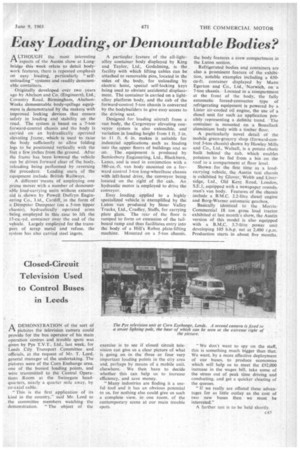Easy Loading, or Demountable Bodies?
Page 87

If you've noticed an error in this article please click here to report it so we can fix it.
ALTHOUGH the most interesting aspects of the Austin show at Longbridge this week relate to detail bodywork features, there is repeated emphasis on easy loading, particularly " selfunloading " systems and readily demountable containers.
Originally developed over two years ago by Abelson and Co. (Engineers), Ltd., Coventry Road, Birmingham, AbelsonWeeks demountable body-spillage equipment is demonstrated by the makers with improved locking devices that ensure, safety in loading and stability on the road. The system is based on a 7-ton forward-control chassis and the body is carried on an hydraulically operated elevating frame, which-is used to raise the body sufficiently to allow folding legs to be positioned vertically with the feet a few inches from the ground. After the frame has been lowered the vehicle can be driven forward clear of the body, reloading being performed by reversing the procedure. Leading users of the equipment include British Railways.
A different 'means of employing one prime mover with a number of demountable load-carrying units without external aid is shown by Powell Duffryn Engineering Co.. Ltd., Cardiff, in the form of a Dempster Dumpster (on a 5-ton tipper chassis), hydraulically operated arms • being employed in this case to lift the 15-cu.-yd. container over the end of the vehicle. Largely employed for the transport of scrap metal and refuse. the system has also carried steel ingots. A particular feature of the all-lightalloy container body displayed by King and Taylor, Ltd., Godalming, is the _ facility with which lifting cables can be attached to removable pins, located in the sides of The body, for unloading by electric hoist, special self-locking keys being used to obviate accidental displacement. The container is carried on a lightalloy platform body, and the cab of the forward-control 5-ton chassis is converted by the bodybuilders to give easy access to the driving seat.
Designed for loading aircraft from a van body, the Cargoveyor elevating conveyor system is also extensible, and variation in loading height from 1 ft. 3 in. to II ft. 6 in. makes it suitable for industrial -applications such as loading into the upper floors of buildings and so on. The equipment is produced by Samlesbury Engineering, Ltd., Blackburn, Lanes, and is used in conjunction with a 580-cu.-ft. van body mounted on a forward control 3-ton long-wheelbase chassis with left-hand drive, the conveyor being located on the right of the cab. An hydraulic motor is employed to drive the conveyor.
Easy loading applied to a highly specialized vehicle is exemplified by the Luton van produced by Stour Valley Trucks, Ltd., Cradley, Staffs, for carrying plate glass. The rear of the floor is ramped to form an extension of the tailboard ramp and thus facilitates entry into the body of a Hill's Robot plate-lifting machine. Mounted on a 5-ton chassis, the body features a crew compartment in the Luton section.
Refrigerated bodies and containers are also a prominent feature of the exhibition, notable examples including a 650cu-ft. container displayed by Mann Egerton and Co., Ltd., Norwich, on a 7-ton chassis. Located in a compartment at the front of the body, the fully automatic forced-convector type of refrigerating equipment is powered by a Lister air-cooled oil engine, the use of a diesel unit for such an application possibly representing a definite trend. The container is mounted on a Bonallack aluminium body with a timber floor.
A particularly novel detail of the mobile green-grocery shop (forward-control 3-ton chassis) shown by Hawley Mills and Co., Ltd., Walsall, is a potato chute built behind the cab, which enables potatoes to be fed from a bin on the roof to a compartment at floor level.
Shown for the first time as a loadcarrying vehicle, the Austin taxi chassis is exhibited by Glover, Webb and Liversidge, Ltd., Old Kent Road, London. S.E.I, equipped with a newspaper roundsman's van body. Features of the chassis include a B.M.C. 2.2-litre diesel engine and Borg-Warner automatic gearbox.
Basically identical to the MorrisCommercial 18 ton gross load tractor exhibited at last month's show, the Austin version of this model is also equipped with a B.M.C. 5.7-litre power unit developing 105 b.h.p. net at 2,400 r.p.m. Production starts in about five months.
















































































































































